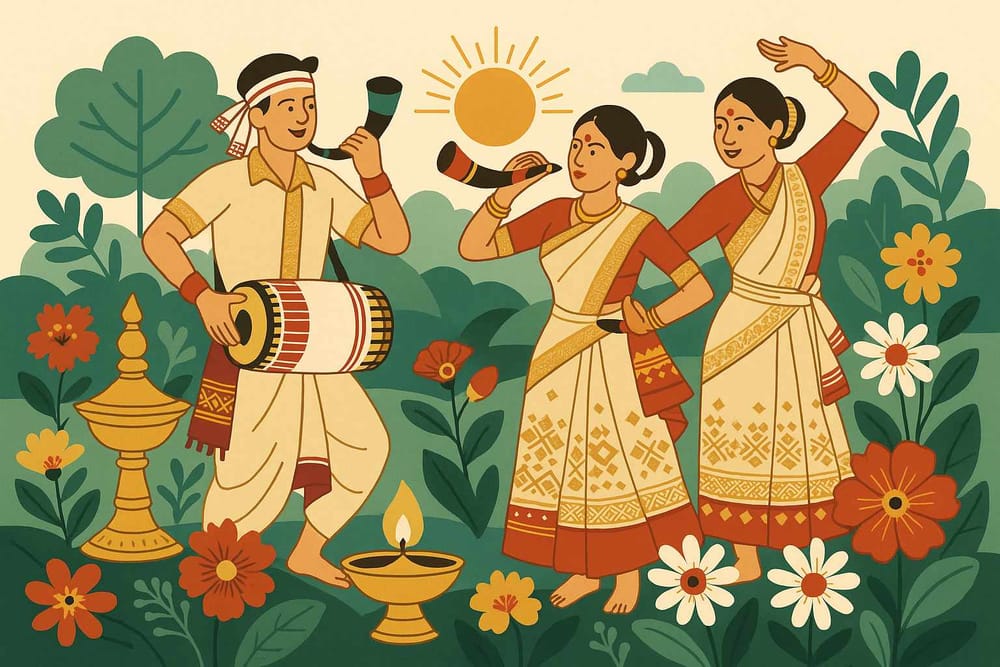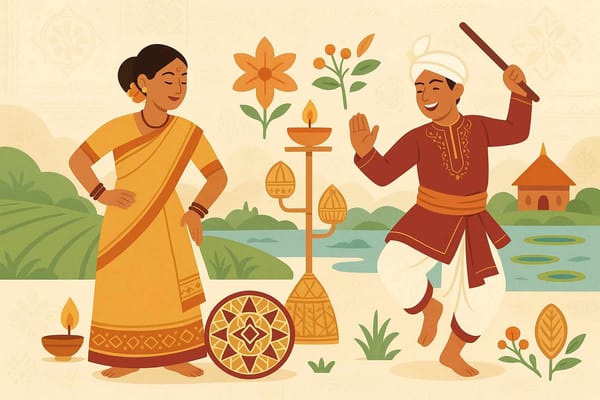
Exploring the Richness of Assamese Culture- A 2025 Guide
There's a certain magic in the air of Assam. It's a land where the mighty Brahmaputra river doesn't just flow, it breathes life into everything around it. It’s the gentle rustle of tea leaves, the rhythmic beat of the *dhol* during Bihu, and the comforting aroma of *pitha* being prepared in a family kitchen. This isn't just a place on a map; it's an emotion, a living, breathing culture that has been nurtured for centuries. Join me as we take a heartfelt journey into the traditions, festivals, and way of life that make Assam so incredibly special, with a glimpse of what 2025 holds for this enchanting land.
The Heartbeat of Assam: Where Tradition Meets Life
To understand Assam, you must first understand its roots. The culture here is a beautiful tapestry woven with threads from various communities—Indo-Aryan, Austroasiatic, and Tibeto-Burman influences have all found a home here. The great Ahom dynasty, which ruled for nearly 600 years, left an indelible mark, creating a legacy of harmony and resilience. These royal traditions continue to shape local celebrations, preserving a rich historical heritage.
At the spiritual core of Assam is the neo-Vaishnavite movement started by the great saint Srimanta Sankardev. He didn't just spread a philosophy of devotion; he united communities through art. He gave us the beautiful Sattriya dance, a classical form that tells stories of faith and devotion, and the soul-stirring *Borgeet* (celestial songs). This spiritual foundation is what holds the diverse communities together, creating a shared sense of identity.
The Rhythm of Joy: Assam's Festivals in 2025
Nowhere is the spirit of Assam more alive than in its festivals. They are not just dates on a calendar but a celebration of nature, agriculture, and community bonds. If you ask what makes the festivals here so unique, it’s how deeply they are connected to the cycles of the earth.
The Soul of Assam: Bihu
Bihu is more than just a festival; it's the very lifeblood of Assam, celebrated three times a year with immense joy. It’s when the entire state erupts in music, dance, and feasting.
- Rongali Bihu (Bohag Bihu): Get ready for the grandest celebration from April 14th to 20th, 2025! This marks the Assamese New Year and the arrival of spring. The air fills with the sound of the *pepa* (buffalo hornpipe) and the energetic steps of the Bihu dance. The first day, Goru Bihu, is dedicated to honouring the cattle that are so vital to an agricultural society.
- Bhogali Bihu (Magh Bihu): Celebrated around January 15th, 2025, this is the festival of feasting! It marks the end of the harvest season. The night before, called Uruka, is all about community feasts. People build Meji—tall structures of bamboo and hay—and light them in the morning, offering prayers to the fire god for a bountiful future.
- Kongali Bihu (Kati Bihu): This is a more solemn and quiet Bihu, observed around October 18th, 2025. Earthen lamps are lit in paddy fields and in front of the sacred Tulsi plant at home, with prayers offered for a good harvest and the protection of crops.
These celebrations are a beautiful part of India's festive soul, a testament to the country's deep spiritual and cultural connections.
Other Spiritual Gatherings
Beyond Bihu, Assam is home to many other powerful spiritual events. The Ambubachi Mela at the Kamakhya Temple in Guwahati (around June 22-26, 2025) is one of the biggest congregations of tantric devotees in the world. The Ahom community remembers their ancestors during Me-Dum-Me-Phi on January 31st, a deeply moving ceremony of reverence and respect.
A Taste of Home: The Flavours of Assamese Cuisine
Many people often wonder what makes Assamese food so distinct. The secret lies in its simplicity, its use of fresh, local herbs, and its unique flavours that are both subtle and profound. It’s food that tastes like home.
- Masor Tenga: This tangy fish curry is the undisputed star of Assamese cuisine. Made with tomatoes, outenga (elephant apple), or lemon, it’s a light, refreshing, and incredibly flavourful dish that you will find in every household.
- Khar: A unique Assamese specialty made using an alkaline liquid extracted from sun-dried banana peels. It’s usually prepared with raw papaya or pulses and has a distinct, earthy taste that is truly one-of-a-kind.
- Pitha and Laru: No festival, especially Bihu, is complete without these traditional sweets. Pithas are delicious rice cakes, with popular varieties like Til Pitha (stuffed with sesame seeds and jaggery) and Narikol Pitha (filled with coconut). Larus are sweet balls made from coconut, puffed rice, or sesame.
Woven in Dreams: Art and Crafts of Assam
The artistry of the Assamese people is woven into the very fabric of their daily lives. You’ll see it in the clothes they wear, the items they use, and the stories they tell through dance.
People often ask about the cultural significance of Assamese silk. It is not just a piece of cloth; it is a symbol of pride and heritage. The golden Muga silk, known for its incredible durability and natural sheen, is exclusive to Assam. The warm Eri silk is known as "ahimsa silk" because the silkworms are not killed in the process. The traditional attire for women, the Mekhela Chador, is a masterpiece of grace and elegance, often handwoven with intricate motifs inspired by nature.
The traditional dance forms are a sight to behold. While the Bihu dance is an expression of pure joy and festivity, the Sattriya dance is a form of worship, born in the monasteries or Sattras of Assam. Its graceful movements and expressive storytelling are a beautiful window into the state's spiritual heart.
Moreover, the traditional crafts here speak volumes about the artisans' connection with nature. From intricate bamboo and cane furniture to the unique masks made in Majuli and the timeless bell metal items, these crafts are a vital part of Assam's cultural and economic identity.
Exploring these deep-rooted spiritual and artistic traditions can be a profoundly moving experience. If you wish to dive deeper into devotional stories and knowledge from Assam and other parts of India, Bhaktilipi.in is a space created just for that. We are dedicated to preserving and sharing this timeless wisdom in a way that resonates with today’s world.
Embracing Assam's Timeless Spirit
Assam's culture is not a relic of the past; it is a living, evolving heritage. It’s in the warmth of the people, the unity in their celebrations, and the deep respect for nature and tradition. Whether you plan to visit this magical land in 2025 or simply wish to embrace its essence from afar, let its authenticity and warmth inspire you.
Understanding and celebrating these traditions is our way of honouring our ancestors and ensuring that the stories, flavours, and colours of Assam continue to enchant generations to come.
About Bhaktilipi
© 2025 Bhaktilipi – Crafted with devotion.
Bhaktilipi is your digital space to explore and preserve timeless bhakti literature across regions and languages. We focus on sharing authentic devotional stories and knowledge that connect with today's readers while honouring tradition.
Discover the richness of Assamese culture and other devotional texts on our platform. Learn, grow, and stay inspired by exploring meaningful content that keeps you connected to your roots.
Subscribe to our newsletter for updates, and follow us on Facebook, Instagram, and YouTube for more devotional insights.
A passionate group of people dedicated to preserving India's knowledge of Dharma, Karma, and Bhakti for ourselves and the world 🙏.
Comments
Related in

Exploring the Rich Tapestry of Assamese and Meitei Cultures: A 2025 Guide
Have you ever felt the pull of a land where the mighty river sings ancient tales and the hills seem to dance in prayer? That, my friend, is the magic of Northeast India. It’s a feeling that stays with you long after you’ve left. Today, let’s take
